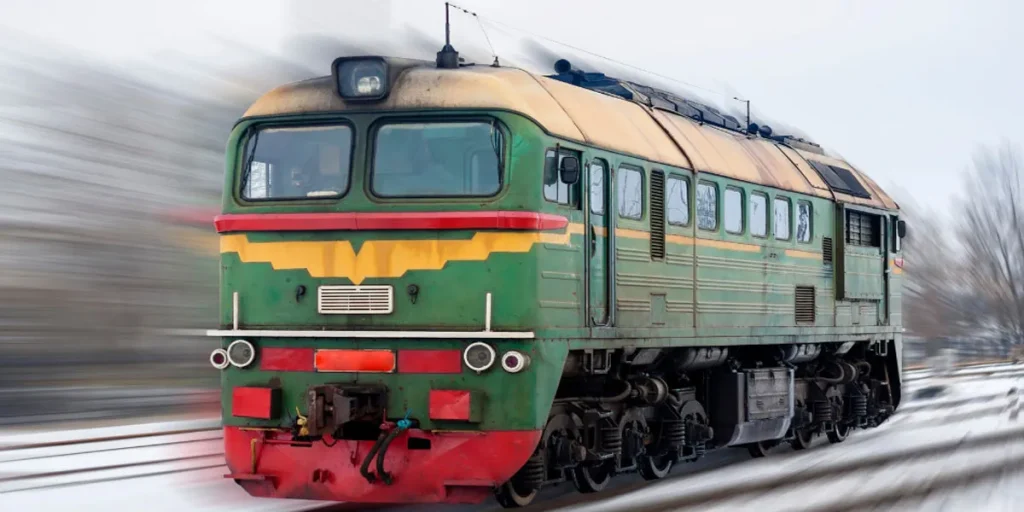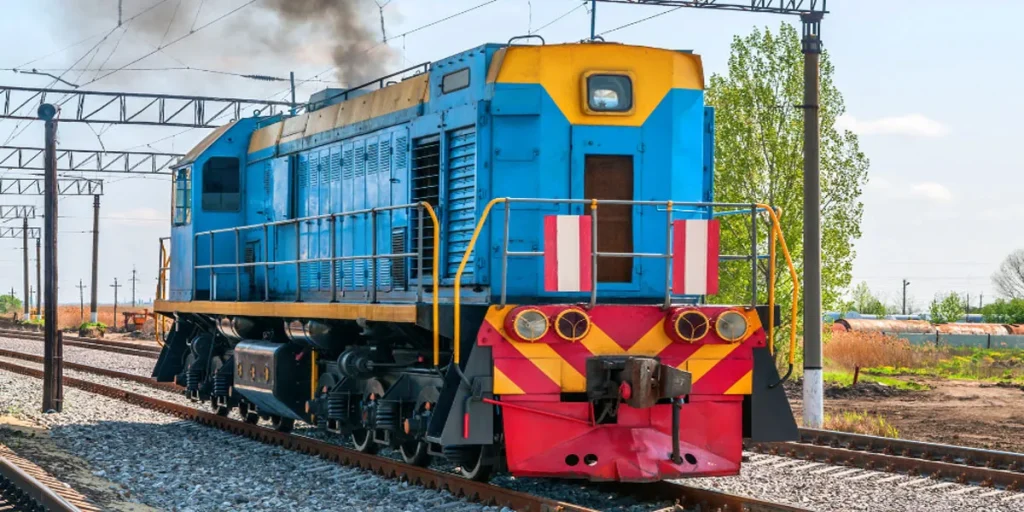A typical diesel locomotive weighs between 100 and 200 tons. Their weight varies depending on the model and purpose.
Exploring the world of rail transport, one discovers the critical role diesel locomotives play in moving goods and people across vast distances.
With a substantial weight averaging from 200,000 to 400,000 pounds, these powerful machines exhibit strength and sturdiness.
Advanced engineering allows them to haul impressive loads, highlighting their importance in the freight and transportation industry.
The heft of a diesel locomotive directly relates to its tractive effort capabilities, ensuring it can tackle the demanding tasks of pulling numerous railcars across diverse terrains.
These locomotives are marvels of modern transport technology, designed to optimize performance and efficiency while navigating the world’s railways.
Unwrapping The Giants On Rails
Imagine a metal giant thundering down the tracks. This giant, a diesel locomotive, powers countless journeys across continents.
These machines captivate with their sheer size and strength. But ever wondered just how much one of these behemoths weighs?
Let’s unwrap the giants on rails and explore the titanic numbers behind them.
Size And Power Of Diesel Locomotives
Diesel locomotives are the muscle of the railway world. Their size is jaw-dropping. Engines may stretch over 70 feet long and stand about 15 feet tall.
Now, power matches size. Most diesel engines pack between 3,000 to 5,000 horsepower. This power lets them haul thousands of tons without breaking a sweat.
| Length | Height | Horsepower |
|---|---|---|
| 70+ feet | 15 feet | 3,000 – 5,000 |
The Significance Of Weight
The weight of a diesel locomotive is a balancing act. Too light, and it lacks the grip for pulling power. Too heavy, and it’s inefficient.
Locomotives tip the scales at roughly 200 to 220 tons. Their weight stabilizes at high speeds. It also maximizes traction on the tracks. The scale of these machines is crucial to their role.
- Optimal weight ensures maximum efficiency and safety.
- Heavier designs concentrate on freight and heavy loads.
- Lighter models suit passenger transport and high-speed needs.
The Anatomy Of A Diesel Locomotive

Understanding the anatomy of a diesel locomotive reveals why these massive machines are more than just metal behemoths.
Each component of a locomotive not only plays a crucial role in its operation but also contributes to its impressive weight.
Key Components And Their Contributions
A diesel locomotive is a complex assembly of parts, each vital for movement. Let’s explore the core elements that make up these iron giants.
- The Engine: Heart of the locomotive, generating the necessary power.
- The Frame: A strong foundation supporting all components.
- Wheels and Axles: They carry the total weight and enable movement.
- Fuel Tank: Stores diesel, the source of the engine’s power.
- Traction Motors: These transfer power to the wheels from the engine.
- The Cab: Houses controls and the crew operating the locomotive.
Each of these parts, made from heavy-duty materials, adds significant weight to the construction.
Materials That Add To The Bulk
Material choices ensure durability and the ability to handle heavy loads.
| Material | Use | Weight Contribution |
|---|---|---|
| Steel | Frame, wheels, body | Most of the weight |
| Copper | Traction motors | Significant |
| Lead | Batteries | Hefty |
| Aluminum | Various components | Lesser, but noteworthy |
The combined weight of these materials lets a locomotive tip the scales at anywhere from 100 to 200 tons.
Weighty Figures: Actual Numbers

The weight of a diesel locomotive is a massive figure.
These iron giants traverse the rails with incredible power.
Some of them tip the scales at over hundreds of tons.
Average Weight Range Of Diesel Locomotives
Diesel locomotives vary widely in weight.
The average weight lies between the following numbers:
| Type of Locomotive | Weight (in tons) |
|---|---|
| Switchers | 60 – 70 |
| Road Switchers | 130 – 150 |
| Road Freight | 200 – 210 |
Record Holders: The Heaviest Locomotives
Locomotives have broken records with their weights.
Some of the heaviest ever are listed below:
- Union Pacific Big Boy – 600 tons
- EMD SD90MAC-H – 415 tons
- GE AC6000CW – 423 tons
These locomotives showcase the marvel of engineering.
They can carry immense loads over long distances.
They truly are the heavyweights of the rail industry.
Factors Influencing Locomotive Weight
The weight of a diesel locomotive can vary widely. Various factors can influence how heavy these powerful vehicles are.
Knowing what affects a diesel locomotive’s weight is crucial for understanding its performance and capabilities.
Power Needs And Tractive Effort
Locomotive weight is closely tied to its power requirements and the tractive effort it can exert. Consider these key points:
- Horsepower: More horsepower often means a heavier engine.
- Fuel capacity: Larger fuel tanks contribute to overall weight.
- Tractive Effort: Heavier locomotives can pull more due to increased traction.
Design And Technological Advancements
Locomotive design and technology also play a pivotal role in determining weight. Let’s explore:
- Materials: Strong but lightweight materials cut down on weight without sacrificing strength.
- Size: Bigger designs often weigh more due to added materials and features.
- Technological Features: Modern electronics and systems can either increase or decrease weight, depending on their nature.
Operational Implications Of Locomotive Weight
The weight of a diesel locomotive plays a pivotal role in its operations. It influences everything from fuel consumption to track wear.
Understanding these operational implications ensures that rail companies maintain efficiency and safety in their daily functions.
Below we delve into the key aspects of how a locomotive’s weight impacts rail infrastructure and what considerations are taken for efficiency and safety.
Impact On Rail Infrastructure
A heavy locomotive exerts more pressure on the tracks. This can lead to a need for frequent maintenance and increased costs. Here’s how weight affects railway components:
- Rails: Excess weight can cause rail deformation over time.
- Track Beds: Substructure might compact or shift, necessitating repairs.
- Bridges: These structures have weight limits for safe operation.
- Signals and Junctions: Enhanced stress can increase the wear on these crucial elements.
Managing weight distribution is crucial to keep the infrastructure safe and functional.
Weight Considerations For Efficiency And Safety
Efficient and safe locomotive operation results from balancing weight. Key factors include:
| Factor | Role of Weight |
|---|---|
| Fuel Efficiency | Heavier locomotives consume more fuel. |
| Braking Systems | Additional weight requires more robust systems to stop safely. |
| Load Capacity | Weight limits determine how much cargo a train can carry. |
| Speed Limits | Higher weights typically lead to lower allowable speeds. |
To optimize these aspects, rail companies meticulously calculate and distribute weight.
This not only ensures compliance with regulations but also enhances overall performance and safety.
Comparative Weights: Diesel Vs. Other Locomotives
Throughout rail history, locomotive weights have varied significantly. Diesel engines revolutionized the railway, offering a balance of weight and power.
Yet, how do they stack up against other types of locomotives? Let’s dive into a weight comparison between diesel and its counterparts.
Diesel Versus Electric Locomotives
The battle of the engines takes us to diesel versus electric. Diesel locomotives are beasts of burden, known for their hefty frames.
A standard diesel unit weighs in at around 200 to 220 tons. These powerhouses can haul massive loads over long distances without recharging.
- Electric locomotives, on the other hand, are lighter. They tip the scales at 80 to 160 tons.
- Their weight is less due to the absence of heavy diesel engines and fuel tanks.
Let’s visualize this comparison:
| Type of Locomotive | Average Weight (tons) |
|---|---|
| Diesel | 200-220 |
| Electric | 80-160 |
How Steam Locomotives Tipped The Scales?
The grandfathers of the railroads, steam locomotives, were true giants. Originating in the 1800s, these locomotives were heavyweights due to their massive boilers and complex machinery.
- Early models ranged from 60 to 120 tons.
- Larger, more powerful steam locomotives could reach up to 300 tons.
Compared to diesels, steam locomotives could be lighter or significantly heavier, depending on their design and intended use. Here’s a brief weight comparison:
| Type of Locomotive | Weight Range (tons) |
|---|---|
| Steam (Early Models) | 60-120 |
| Steam (Large Models) | Up to 300 |
FAQs About the Weight of a Diesel Locomotive
What Is The Average Weight Of A Diesel Locomotive?
A typical diesel locomotive weighs about 210,000 to 220,000 pounds or 105 to 110 tons.
This weight can fluctuate based on the locomotive’s model, age, and specifications.
How Do Diesel Locomotive Weights Compare?
Diesel locomotives are generally heavier than most other land vehicles.
They often weigh more than twice as much as a standard semi-truck, reflecting their power and durability required for heavy cargo.
Why Do Diesel Locomotives Weigh So Much?
Diesel locomotives weigh a lot due to their sturdy construction, powerful engines, and additional components like large fuel tanks.
Their heavyweight aids in traction and stability when hauling large loads on the tracks.
Can The Weight Of A Locomotive Affect Its Performance?
Yes, the weight of a locomotive directly impacts its performance.
Heavier locomotives can pull more cargo but may consume more fuel and require more maintenance. Weight balance is crucial for efficient operation.
Conclusion
Understanding the weight of diesel locomotives is crucial for logistics and transportation professionals.
These steel behemoths, averaging between 100 – 200 tons, showcase the might of modern engineering.
For rail enthusiasts and industry experts alike, comprehending these figures is not just informative but essential.
Factors influencing weight, like model and cargo capacity, play vital roles. Remember, the weight of a locomotive is a key to its power and efficiency on the tracks.
Resources:
https://www.nps.gov/parkhistory/online_books/steamtown/shs5.htm
https://science.howstuffworks.com/transport/engines-equipment/diesel-locomotive.htm
